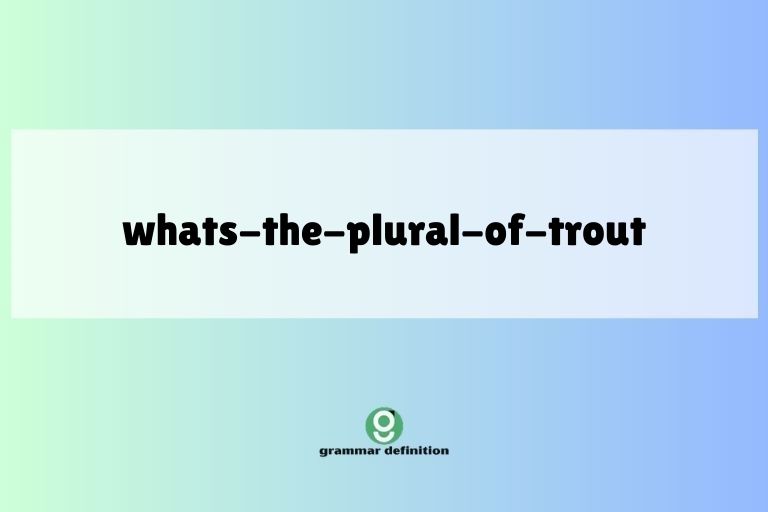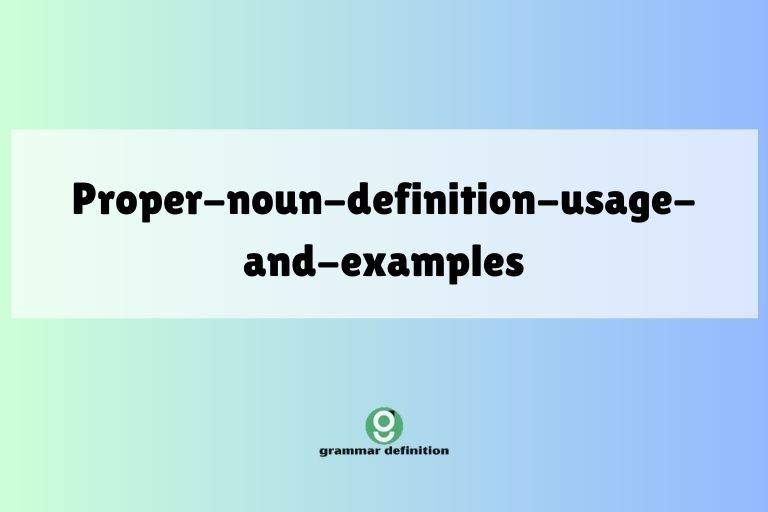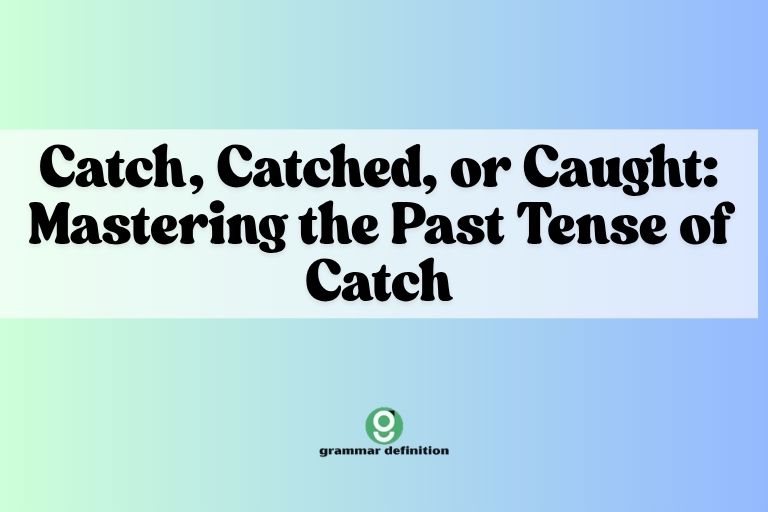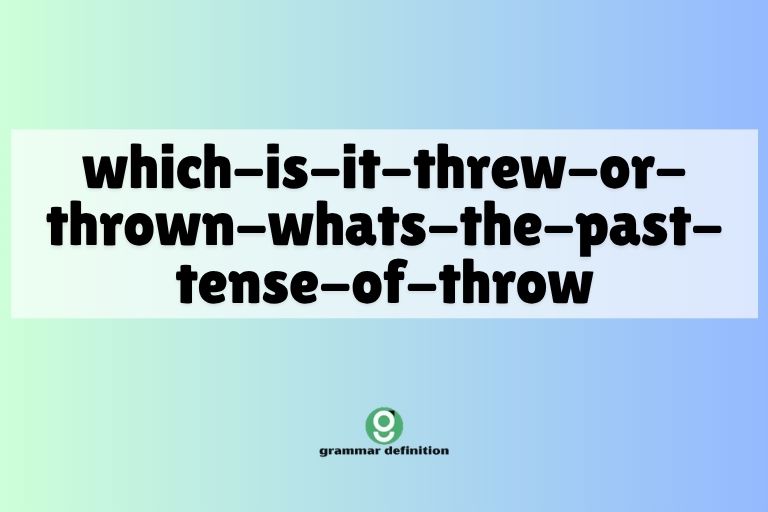What’s the Plural of Trout? A Comprehensive Guide

Understanding the nuances of pluralization in English can sometimes feel like navigating a tricky stream. While most nouns simply add an “-s” to become plural, some words, like “trout,” have unique rules.
Mastering these exceptions is crucial for clear and accurate communication, particularly in scientific writing, culinary contexts, and everyday conversations. This article provides a comprehensive guide to understanding the plural of “trout,” exploring its grammatical roots, usage rules, and common pitfalls.
Whether you’re a student, writer, or language enthusiast, this guide will equip you with the knowledge to confidently use “trout” in both its singular and plural forms.
This article will benefit anyone who wants to improve their grammar skills, especially those working with scientific writing, culinary arts, or simply want to speak and write English more accurately. Understanding the pluralization of words like “trout” demonstrates a command of English and enhances communication skills.
Table of Contents
- Introduction
- Definition of Trout
- Structural Breakdown: Singular and Plural
- Types of Trout
- Examples of Trout in Sentences
- Usage Rules for Trout
- Common Mistakes and Corrections
- Practice Exercises
- Advanced Topics: Irregular Plurals and Collective Nouns
- Frequently Asked Questions
- Conclusion
Definition of Trout
A trout is a common name for a number of species of freshwater fish belonging to the genera Oncorhynchus, Salmo, and Salvelinus, all of which are part of the subfamily Salmoninae of the family Salmonidae. These fish are closely related to salmon and char. Trout are typically found in clear, cool streams and lakes, and they are highly valued for both recreational fishing and as a food source. The term “trout” encompasses a wide variety of species, each with its own unique characteristics and habitat.
In biological classification, trout are categorized within the animal kingdom, phylum Chordata, class Actinopterygii (ray-finned fishes), order Salmoniformes, and family Salmonidae. Their function in the ecosystem is significant as both predators and prey, contributing to the balance of aquatic life.
They are also economically important, supporting fishing industries and tourism in many regions. Contextually, the word “trout” can appear in scientific literature, culinary recipes, fishing reports, and general conversation.
Structural Breakdown: Singular and Plural
The noun “trout” is unique in that its plural form is generally the same as its singular form. This means that whether you’re talking about one fish or many, you often use the word “trout.” However, there are specific instances where “trouts” can be used, primarily when referring to different species or types of trout.
Here’s a breakdown:
- Singular: trout (e.g., “I caught a trout.”)
- Plural (General): trout (e.g., “There are many trout in the river.”)
- Plural (Specific Types): trouts (e.g., “The aquarium features rainbow trouts and brown trouts.”)
The use of “trouts” to denote different species is less common but grammatically acceptable. In most cases, sticking with “trout” for the plural form is the safest and most widely accepted option.
Types of Trout
The term “trout” encompasses numerous species and subspecies, each with distinct characteristics. Understanding these different types can help clarify when the plural form “trouts” might be appropriate.
Here are some common types of trout:
- Rainbow Trout (Oncorhynchus mykiss): Native to western North America and widely introduced elsewhere. Known for its vibrant coloration.
- Brown Trout (Salmo trutta): Native to Europe and western Asia, also introduced to other continents. Can tolerate warmer waters than some other trout species.
- Brook Trout (Salvelinus fontinalis): Native to eastern North America. Characterized by its dark green to brown color with light markings.
- Lake Trout (Salvelinus namaycush): Found in large lakes in northern North America. Can grow to be quite large.
- Cutthroat Trout (Oncorhynchus clarkii): Native to western North America. Identified by the red or orange markings under its lower jaw.
- Golden Trout (Oncorhynchus mykiss aguabonita): A subspecies of rainbow trout native to California. Known for its bright golden color.
When discussing a collection of different types of trout, using “trouts” becomes more acceptable. For example, a biologist might say, “The study examined various trouts from different regions.”
Examples of Trout in Sentences
To further illustrate the usage of “trout” in both singular and plural forms, let’s look at some examples. These examples are categorized to highlight the different contexts in which “trout” can be used.
Singular Examples
The following table provides examples of “trout” used in its singular form. Notice how each sentence refers to a single fish.
| Sentence | Context |
|---|---|
| I caught a trout on my fishing trip. | Recreational fishing |
| The chef prepared a delicious trout for dinner. | Culinary |
| A trout swam upstream against the current. | Nature observation |
| The biologist tagged the trout for research purposes. | Scientific research |
| He released the small trout back into the river. | Conservation |
| She painted a beautiful picture of a trout. | Art |
| The menu featured pan-fried trout with lemon. | Restaurant menu |
| A single trout can lay thousands of eggs. | Biology |
| The fisherman proudly displayed his trout. | Fishing competition |
| The stream is known for its large trout. | Tourism |
| The recipe called for a fresh trout. | Cooking |
| He carefully cleaned the trout before cooking it. | Food preparation |
| The trout jumped out of the water. | Wildlife observation |
| The documentary showed a trout in its natural habitat. | Documentary film |
| The angler used a special lure to attract the trout. | Fishing technique |
| The trout was silver and sleek. | Description |
| My son caught his first trout today. | Personal anecdote |
| The guide pointed out a trout hiding under a rock. | Guided tour |
| The trout is a popular game fish. | General knowledge |
| I ordered the grilled trout at the restaurant. | Dining experience |
| The trout fought hard before being reeled in. | Fishing |
| A trout can live for several years in the wild. | Ecology |
| The stream is stocked with trout every spring. | Conservation |
| The trout is a symbol of the region’s natural beauty. | Local culture |
| I prefer to cook trout with herbs and butter. | Culinary preference |
| The trout is a valuable resource for local communities. | Economic impact |
| The trout population is carefully monitored by scientists. | Environmental science |
Plural Examples
The following table provides examples of “trout” used in its plural form. Notice how each sentence refers to multiple fish.
In most cases, “trout” is used as the plural, but “trouts” is used when referring to different species.
| Sentence | Context |
|---|---|
| There are many trout in this river. | General observation |
| The aquarium features rainbow trouts and brown trouts. | Different species |
| We caught several trout during our fishing trip. | Recreational fishing |
| The chef prepared a platter of grilled trout. | Culinary |
| The trout swam upstream to spawn. | Nature observation |
| The biologists tagged hundreds of trout for research. | Scientific research |
| They released the young trout into the lake. | Conservation |
| The painting depicted a school of trout. | Art |
| The restaurant served a variety of trout dishes. | Restaurant menu |
| These trout are known for their vibrant colors. | Biology |
| The fishermen displayed their trout at the competition. | Fishing competition |
| The streams are teeming with trout. | Tourism |
| The recipe requires fresh trout. | Cooking |
| He cleaned the trout before grilling them. | Food preparation |
| The trout jumped out of the water in unison. | Wildlife observation |
| The documentary showed trout in their natural habitat. | Documentary film |
| The anglers used special lures to attract the trout. | Fishing technique |
| The trout were silver and sleek. | Description |
| My children caught several trout today. | Personal anecdote |
| The guide pointed out trout hiding under the rocks. | Guided tour |
| Trout are popular game fish. | General knowledge |
| I ordered the grilled trout for the whole table. | Dining experience |
| The trout fought hard before being reeled in. | Fishing |
| Trout can live for several years in the wild. | Ecology |
| The streams are stocked with trout every spring. | Conservation |
| Trout are a symbol of the region’s natural beauty. | Local culture |
| I prefer to cook trout with herbs and butter for a large group. | Culinary preference |
| Trout are a valuable resource for local communities. | Economic impact |
| The trout populations are carefully monitored by scientists. | Environmental science |
Collective Noun Examples
A collective noun refers to a group of individuals considered as a single unit. While “trout” itself can function as a plural noun, there aren’t specific, widely recognized collective nouns exclusively for trout.
However, you might use general collective nouns for fish, such as “school” or “shoal,” when referring to a group of trout.
| Sentence | Context |
|---|---|
| A school of trout swam by. | General observation |
| The shoal of trout moved in unison. | Nature observation |
| The group of trout was feeding near the surface. | Wildlife observation |
| A small collection of trout was observed in the stream. | Scientific observation |
Usage Rules for Trout
Here’s a breakdown of the usage rules for “trout”:
- General Plural: Use “trout” as the plural form when referring to multiple fish of the same species or a mixed group of trout.
- Specific Types: Use “trouts” when specifically referring to different species or types of trout. This usage is less common but grammatically correct.
- Consistency: Maintain consistency in your writing. If you start by using “trout” as the plural, stick with it unless you need to differentiate between species.
- Clarity: Ensure your sentence is clear and unambiguous. If there’s a chance of confusion, rephrase the sentence to avoid ambiguity. For example, instead of saying “The trouts were studied,” you could say “Different species of trout were studied.”
The key is to prioritize clarity and accuracy in your writing. While “trouts” is technically correct in certain contexts, using “trout” as the plural is generally safer and more widely accepted.
Common Mistakes and Corrections
One of the most common mistakes is using “trouts” when referring to a general group of trout. Here are some examples of common mistakes and their corrections:
| Incorrect | Correct | Explanation |
|---|---|---|
| We caught many trouts in the river. | We caught many trout in the river. | “Trout” is the standard plural form. |
| The lake is full of trouts. | The lake is full of trout. | “Trout” is the standard plural form. |
| I saw several trouts swimming upstream. | I saw several trout swimming upstream. | “Trout” is the standard plural form. |
| All the trouts were released back into the wild. | All the trout were released back into the wild. | “Trout” is the standard plural form. |
| The trouts in this area are especially large. | The trout in this area are especially large. | “Trout” is the standard plural form. |
| The biologists are studying the trouts population. | The biologists are studying the trout population. | “Trout” is the standard plural form. |
However, using “trouts” is acceptable when referring to different species:
| Incorrect | Correct | Explanation |
|---|---|---|
| The aquarium had rainbow trout and brown trout. | The aquarium had rainbow trouts and brown trouts. | Specifying different species makes “trouts” acceptable. |
Practice Exercises
Test your understanding of the pluralization of “trout” with these practice exercises.
Exercise 1: Fill in the Blanks
Fill in the blanks with the correct form of “trout” (trout or trouts).
| Question | Answer |
|---|---|
| 1. There are several ______ swimming in the stream. | trout |
| 2. The aquarium features rainbow ______ and golden ______. | trouts, trouts |
| 3. He caught a large ______ on his fishing trip. | trout |
| 4. The recipe calls for fresh ______. | trout |
| 5. The biologists are studying the ______ population in the lake. | trout |
| 6. I saw a school of ______ while snorkeling. | trout |
| 7. The menu includes grilled ______ with lemon and herbs. | trout |
| 8. The river is known for its abundance of ______. | trout |
| 9. The differences between the various ______ are subtle but important. | trouts |
| 10. We released the young ______ back into the river. | trout |
Exercise 2: Correct the Sentences
Correct the following sentences if they contain an error in the use of “trout” or “trouts.” If the sentence is correct, write “Correct.”
| Question | Answer |
|---|---|
| 1. We saw many trouts in the hatchery. | We saw many trout in the hatchery. |
| 2. The aquarium had brook trouts and lake trouts. | Correct |
| 3. I only caught one trout all day. | Correct |
| 4. The recipe requires two fresh trouts. | The recipe requires two fresh trout. |
| 5. The biologists are studying the trouts in this region. | The biologists are studying the trout in this region. |
| 6. The trouts swam upstream to spawn. | The trout swam upstream to spawn. |
| 7. The restaurant serves a variety of trout dishes. | Correct |
| 8. These trouts are known for their unique markings. | These trout are known for their unique markings. |
| 9. The fishermen displayed their trouts at the market. | The fishermen displayed their trout at the market. |
| 10. The lake is stocked with thousands of trout each year. | Correct |
Exercise 3: Multiple Choice
Choose the correct sentence from the options provided.
| Question | Options | Answer |
|---|---|---|
| 1. Which sentence is correct? | a) There are many trouts in the river. b) There are many trout in the river. c) There is many trout in the river. | b) There are many trout in the river. |
| 2. Which sentence is correct? | a) The aquarium features rainbow trout and brown trout. b) The aquarium features rainbow trouts and brown trout. c) The aquarium features rainbow trouts and brown trouts. | c) The aquarium features rainbow trouts and brown trouts. |
| 3. Which sentence is correct? | a) I caught a trout yesterday. b) I caught a trouts yesterday. c) I catched a trout yesterday. | a) I caught a trout yesterday. |
| 4. Which sentence is correct? | a) The recipe calls for fresh trouts. b) The recipe calls for fresh trout. c) The recipe call for fresh trout. | b) The recipe calls for fresh trout. |
| 5. Which sentence is correct? | a) The biologists is studying the trout population. b) The biologists are studying the trout population. c) The biologists are studying the trouts population. | b) The biologists are studying the trout population. |
| 6. Which sentence is correct? | a) The trouts were swimming upstream. b) The trout were swimming upstream. c) The trout was swimming upstream. | b) The trout were swimming upstream. |
| 7. Which sentence is correct? | a) We ordered grilled trout for dinner. b) We ordered grilled trouts for dinner. c) We order grilled trout for dinner. | a) We ordered grilled trout for dinner. |
| 8. Which sentence is correct? | a) The fishermen displayed their trouts proudly. b) The fishermen displayed their trout proudly. c) The fisherman displayed their trout proudly. | b) The fishermen displayed their trout proudly. |
| 9. Which sentence is correct? | a) The differences between the trouts are significant. b) The differences between the trout are significant. c) The difference between the trout are significant. | a) The differences between the trouts are significant. |
| 10. Which sentence is correct? | a) They released the young trouts into the lake. b) They released the young trout into the lake. c) They release the young trout into the lake. | b) They released the young trout into the lake. |
Advanced Topics: Irregular Plurals and Collective Nouns
While “trout” follows a relatively simple pattern of pluralization, it’s helpful to understand the broader context of irregular plurals and collective nouns in English.
- Irregular Plurals: Many English nouns have irregular plural forms that don’t simply add “-s” or “-es.” Examples include “child” (children), “mouse” (mice), and “foot” (feet). These irregular forms often have historical roots and can be challenging for language learners.
- Collective Nouns: Collective nouns refer to groups of individuals considered as a single unit. Examples include “team,” “family,” and “committee.” Collective nouns can be singular or plural depending on whether the group is acting as a unit or as individual members. For example, “The team is playing well” (unit) vs. “The team are arguing about the strategy” (individual members).
Understanding these concepts can help you navigate the complexities of English grammar and use nouns correctly in various contexts.
Frequently Asked Questions
Here are some frequently asked questions about the pluralization of “trout”:
- Is it ever correct to use “trouts”?
Yes, it is grammatically correct to use “trouts” when referring to different species or types of trout. However, using “trout” as the plural is generally more common and widely accepted.
- Why is “trout” sometimes used as both singular and plural?
This is a characteristic of some English nouns, particularly those referring to animals or fish. It simplifies the language and avoids unnecessary complexity.
- Should I always use “trout” as the plural form?
In most cases, yes. Using “trout” as the plural is the safest and most widely accepted option. Only use “trouts” when you specifically want to emphasize different species or types.
- Is there a collective noun for trout?
There isn’t a specific, widely recognized collective noun exclusively for trout. General collective nouns for fish, such as “school” or “shoal,” can be used.
- How can I remember the plural form of “trout”?
Think of other similar words like “fish” or “sheep,” which also have the same form for singular and plural. Practice using “trout” in sentences to reinforce the correct usage.
- What is the origin of the word “trout”?
The word “trout” comes from the Middle English “trout,” which is derived from the Old English “truht.” This, in turn, comes from the Proto-Germanic “*truhtaz,” which is related to words for “strong” or “swift,” likely referring to the fish’s swimming ability. This etymology highlights the long history of the word’s usage in the English language and its Germanic roots.
- Are there any regional differences in the usage of “trout” vs. “trouts”?
While the general rule applies across most English-speaking regions, there might be slight variations in colloquial usage. In some areas, “trouts” might be more commonly used even when referring to a general group. However, for formal writing and general communication, sticking to “trout” as the plural is recommended unless specifying different species.
- How does the pluralization of “trout” compare to other fish names?
Many fish names follow a similar pattern to “trout,” where the plural form is the same as the singular. Examples include “fish” itself (though “fishes” is also used to denote different species), “salmon,” and “cod.” This pattern simplifies the language and reflects the common usage of these terms in the context of fishing and aquatic life.
Conclusion
Understanding the pluralization of “trout” is a subtle but important aspect of English grammar. While the standard plural form is “trout,” the use of “trouts” is acceptable when referring to different species or types.
Mastering this rule, along with understanding irregular plurals and collective nouns, will enhance your writing and communication skills.
Remember to prioritize clarity and consistency in your writing. When in doubt, using “trout” as the plural form is generally the safest option.
By practicing these rules and reviewing the examples provided, you’ll be well-equipped to use “trout” correctly in any context, whether you’re discussing your latest fishing adventure or writing a scientific report.






